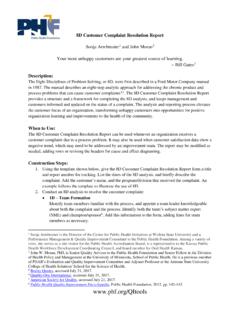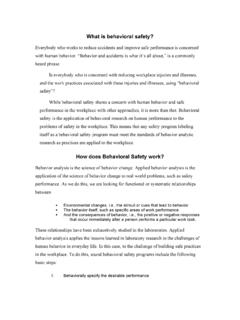Transcription of Facilitating and Coaching Teams: Tips and Techniques
1 Facilitating and Coaching Teams: tips and Techniques Grace L. Duffy, Cathy Montgomery, and John W. Moran (Originally published in Applications and Tools for Creating and Sustaining Healthy Teams, 2011). Facilitating and Coaching teams are learned skills that require education, observation, and hands- on experience. The authors have used facilitation and Coaching Techniques with over a thousand teams to get them back on track and performing at maximum potential. This article includes tips on some effective Techniques for Facilitating and Coaching teams. Facilitation is used in a variety of contexts including training, experiential learning, conflict resolution, and Facilitation is the process of helping groups or individuals learn, find a solution, or reach consensus without imposing or dictating an outcome. Facilitation empowers individuals or groups to learn for themselves or to find their own answers to problems without control or manipulation. Facilitators need good communication skills, including listening, questioning, and reflecting.
2 Coaching is defined as partnering with clients in a thought-provoking and creative process that inspires them to maximize their personal and professional Facilitation and Coaching are closely related. Both facilitators and coaches strive to get clients or teams to improve performance. Coaching is slightly more directive than facilitation. The distinction between facilitation and Coaching often becomes blurred. At times, a group is led through facilitation to a resolution. At other times, directive Coaching is necessary in order to get the group moving. In this chapter the authors assume that the facilitation or Coaching services have been requested by a team experiencing some sort of difficulty reaching their assigned goal. Facilitation/ Coaching interventions must be well planned with the team leader so that additional damage is not done to the team . A facilitator or coach may be assigned to help guide a team through the problem- solving process . The tips and Techniques presented here should be followed at startup to help the team reach its maximum performance level as quickly as possible.
3 Before attempting any team facilitation or Coaching , it is important to make sure that a team Charter is in place as a baseline of the team 's activities. The charter provides start-up direction that a team needs to be successful in tackling the task that it has been assigned. Often teams spend valuable resources trying to figure out what it is they are supposed to do. If the team is struggling with this issue, then the facilitator or coach should get the sponsor together with the team to complete a team charter. 1. The CBS Interactive Business Network. Facilitation. intelligence/facilitation. Copyright 2011. Accessed March 30, 2010. 2. International Coach Federation. Copyright 2010. Accessed March 30, 2010. 1. Example: The Florida Department of Health facilitates a collaborative of nine county health departments (CHD) working on quality improvement projects over a three year period to reduce rates of childhood overweight and obesity in their counties. At the beginning of the project, each CHD coordinated a team of peers to develop goals, objectives, strategies and activities; only one team developed a charter, outlining roles and responsibilities of team members.
4 Each year, a survey was conducted among collaborative team members to assess project successes, lessons learned, use of quality improvement tools, and experience participating in a collaborative. A component of the survey asked participants to provide information and feedback on aspects of their team 's performance. Two-thirds (65%) of survey respondents (n = 17) reported that their project teams were composed of multiple program areas within the CHD. No consistency was shown in the frequency of meetings, and even when teams met, only of respondents said that their meetings were productive. Shifts in priorities ( , H1N1; Haitian relief efforts) and staff turnover reduced the number of members available to work on projects in multiple CHD teams. Other team members became disengaged because their role and purpose were not clear. One team member wrote: (QI) projects often assume people know how to work in teams. In fact, it is a skill set that requires just as much training and guidance as any other (QI) tool.
5 If a person functions in a positive team , there is great satisfaction achieved; however, (QI) tools alone and objectives will not prepare people for basics on how to function as a team .. Successfully Facilitating and Coaching a team requires building a partnership among the facilitator/coach, sponsor, team leader, and team members. This partnership is most effective when ground rules, clear expectations, specific time frames, and goals and measures of success are established. The overall goal is to build a culture of commitment and accountability to the assigned task within the team . The goal of team facilitation and Coaching is to establish trust, build rapport and open communication, clarify key roles and responsibilities, and establish goals. An effective personal development plan and a mentoring agreement should be created between the facilitator/coach and the individuals within the team . To be an effective facilitator and coach, eight key rules need to be followed: 1.
6 Know the needs of the team . The coach must address current team needs, not some desired future state. 2. 2. Confirm that the team is ready to be coached: a. Will they be receptive to Coaching ? b. Have they requested Coaching or been told to receive it? c. What do they expect to get from Coaching ? 3. Set realistic expectations with the team and team sponsor: a. Establish goals for the Coaching or Facilitating outcomes. b. Clarify whether the purpose is to facilitate a team activity or conduct individual team member Coaching . The difference between the two will show up here. c. Build trust, establishing who is to receive a report of results. Making it clear to the team that the outcome of the Coaching is important will help to build trust. d. Establish when and where Coaching or Facilitating will take place. 4. Observe the team : a. Identify destructive behaviors engaged in by individuals. b. Document specific incidences of inappropriate behavior. c. Document strengths and weaknesses of team members and the team as a unit.
7 D. Understand what team members think is hindering their progress toward the goal. 5. Measure where the team is using a team development model such as Tuckman's Group Development Model3 of forming, storming, norming, performing, and adjourning. a. Understand where the team is currently. Document the behaviors that indicate that the team is in that stage. b. Understand the history of the team and what the biggest challenges in working as a team have been. c. In Chapter 3 it was discussed that a well-developed team charter helps to move the team to the performing stage. An effective charter answers a number of issues that usually arise in the norming and storming phase of team startup. The facilitator/coach must ensure that a well-developed team charter is in place before attempting any changes. 6. Develop an Improvement Plan: a. Describe the impact of team behaviors, both positive and detrimental. b. Review causes that lead to bad outcomes for the team . c. Set realistic change expectations for team behavior.
8 D. Build the improvement plan around individual member and team strengths. e. Describe specific corrective actions to overcome observed weaknesses. f. Indicate any training that may be required and how that training may be obtained. 7. Confidentiality: a. Ensure that what is observed, recommended, or assisted with remains confidential. 3. Wikipedia, The Free Encyclopedia. Tuckman's Stages of Group Development. ,_storming,_norming_and_performing, Updated March 25, 2011. Accessed March 29, 2010. 3. b. If a finding must be reported to someone higher in the organization, the team must be informed at the outset. 8. Follow-Up: a. Set a time to follow up with the team to see if progress has been made. b. Ask them to send brief updates on a regular basis about what is and is not working. The following are some typical examples of issues that the authors addressed with teams in facilitation or Coaching roles. Some of these might be encountered when helping a team : Clarify objectives and goals for the team ; return to the team charter.
9 Coach a group of people into a cohesive team . Dissolve hidden agendas held by one or more of the team members. Encourage team members to commit and be accountable for their actions. Help the team define the obstacles that are impacting progress. Coach the team on how to overcome these obstacles. Move from hoping to be a team to acting and functioning like a team . Generate efficiency in the team 's approach to problem analysis. Help the team model other high performing teams' success. Overcome a team 's feeling of frustration and failure. Keep them going through encouragement and recognition so that they finish their task. Coach team members who have a difficult time confronting one another on important issues. Establish and clarify roles and responsibilities for the team members. Develop good meeting practices and set ground rules for the team to follow to enhance their time together. Overcome the disruption of one dominant team member. Encourage and involve those who hold back or are quiet.
10 Help the team focus on the possibilities, not the obstacles. Help resolve destructive differences. Whatever team issue is encountered, it is always a good idea to discuss it with another facilitator/coach to get two viewpoints on how to approach the issue. Once the cause of the issue is fully understood, developing an action plan to get the team back on track is the next step. The need for facilitation and Coaching interventions can be reduced by utilizing the following Guidelines for Teams to Work This list applies to all teams as they begin and progress toward their goal; and can be used as a checklist by the sponsor or team leader to help ensure a smooth teaming process . 4. Fetteroll G, Hoffherr G, Moran J. Growing Teams. Salem, NH: Goal/QPC; 1993. 4. 1. Establishing goals and objectives that all team members accept, thereby developing team ownership is crucial. Before Facilitating or Coaching a team or even presenting information, asking the group what they expect to achieve by the end of the meeting is an important action.


















